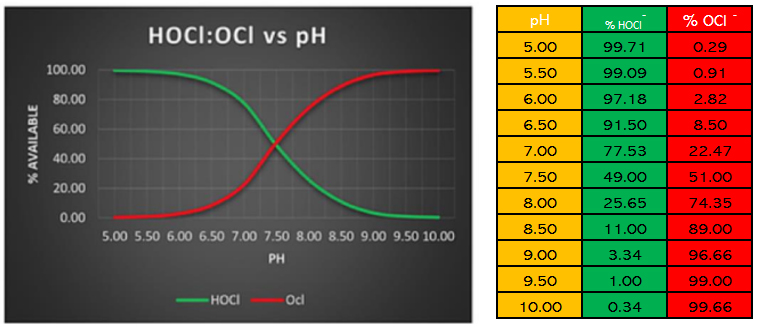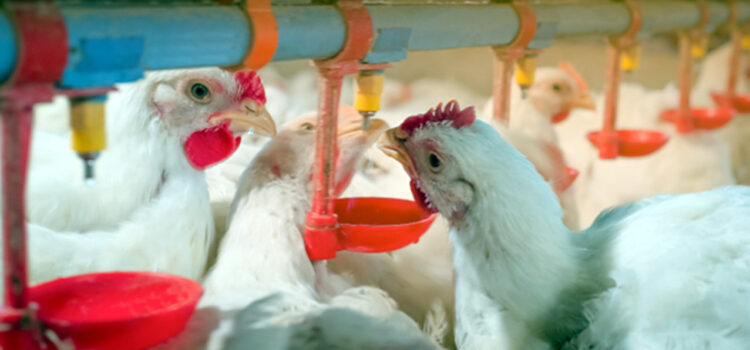Water is a crucial nutrient for poultry, as it accounts for 70% of their body weight and is essential for many physiological functions, such as digestion, temperature regulation, and waste excretion. However, the quality of the water can have a significant impact on the health and productivity of the birds.

Director Business Development
Lotus Ozone Tech Pvt. Ltd.
Bangalore
M: +91 93425 29325
E: vasanth@lotusozone.com
One critical aspect of water quality is pH, which can affect the availability and absorption of nutrients, as well as the growth and survival of microorganisms in the bird’s digestive tract.
- Water is the most essential nutrient for poultry.
- Water is a medium for transporting nutrients along the gastrointestinal tract.
- Water plays an important role in regulating body temperature and is a component of many basic chemical reactions.
- Good quality water is very important for good digestion and to create a healthy gut flora, which will help the bird to absorb all the essential nutrients.
- Constant monitoring of drinking water pH & coliform count is essential.
- It is important for water to remain hygienic all the way until it reaches the birds.
- Water lines should be thoroughly cleaned and sanitized at regular intervals.
The pH of water refers to its acidity or alkalinity level and is measured on a scale of 0 to 14, with 7 being neutral. Water with a pH level below 7 is considered acidic, while water with a pH level above 7 is alkaline. The ideal pH level for poultry water is between 6.0 and 6.5, as this range provides optimal conditions for nutrient absorption and microbial control in the digestive tract.
Water that is too acidic or too alkaline can have negative effects on poultry health and productivity. Acidic water with a pH level below 6.0 can corrode water pipes and equipment, leading to increased levels of heavy metals and other contaminants in the water. It can also cause irritation and damage to the bird’s digestive tract, reducing nutrient absorption and increasing the risk of disease.
On the other hand, alkaline water with a pH level above 8.0 can reduce the solubility of minerals and nutrients in the water, making them less available for absorption by the birds. It can also promote the growth of harmful microorganisms, such as bacteria and algae, in the water, increasing the risk of disease transmission.
To maintain the ideal pH level in poultry water, several factors need to be considered.
The first is the quality of the water source. Water with a high mineral content or alkalinity level may require treatment, such as reverse osmosis or acidification, to adjust the pH level to the optimal range. Sanitation and acidification are the two practices that work together to improve water quality.
The second factor is the type and concentration of minerals and nutrients in the water. Certain minerals, such as calcium and magnesium, can increase the pH level of the water, while others, such as iron and manganese, can decrease it. It’s essential to monitor the levels of these minerals and adjust the pH level as necessary.
The hydrogen ion concentration in water determines the pH level and is very critical for microbial growth. Salmonella, E. coli and Campylobacter can survive in a pH range 4.5 to 8 with an optimum pH for growth around 7 the microorganisms can survive and grow better at an optimum temperature of 37.0 C.
Your water treatment program should complement the water and make the quality consistent over time. Monitoring the water quality before and after water treatment should be part of your program.
pH of Sample:
- Poultry prefer a pH between 6.1-6.8.
- pH less than 6 begins to affect broiler performance due to palatability.
- Low pH water may be corrosive to equipment over a prolonged period.
- High pH water indicates the presence of calcium and magnesium and can negatively affect bird performance and clog water systems. Certain bacteria prefer an acidic environment while others prefer an alkaline environment.
- Beneficial bacteria typically prefer an acidic environment.
- Lactobacillus (beneficial bacteria) prefer a pH of 3.5-6.8.
- A recent study showed that gram negative bacteria (coliforms) had a 7% survival rate at a 6.9pH and a 66.1% survival rate at 8.3 pH.
pH Summary:
- Target a pH of 6.3-7 to maximize performance.
- Birds will drink less when pH is less than 6 or higher than 7.5.
- In general, beneficial bacteria prefer a low pH environment (acidic) and a harmful bacteria prefer a high pH environment (alkaline).
Water Acidifiers:
The Key to Improved Poultry Health Water acidifiers are a type of feed additive that can improve the health and productivity of poultry. They work by reducing the pH level of the water, which can help to control the growth of harmful bacteria and other microorganisms in the bird’s digestive tract. In this article, we’ll explore the benefits of water acidifiers in poultry farming and how they can be used effectively.
Water acidifiers are commonly used in poultry farming as a way to improve the health and productivity of birds. By reducing the pH level of the water, they can help to prevent the growth of harmful bacteria, such as E. coli and Salmonella, in the bird’s digestive tract. This can help to reduce the risk of disease and improve the overall health of the flock.
In addition to their antimicrobial properties, water acidifiers can also improve the absorption of nutrients in the bird’s digestive system. By reducing the pH level of the water, they can help to break down feed particles and improve the efficiency of nutrient uptake. This can lead to improved growth rates and better feed conversion ratios in poultry.
Water acidifiers are also an effective way to reduce the use of antibiotics in poultry farming. By controlling the growth of harmful bacteria in the bird’s digestive tract, water acidifiers can help to reduce the risk of disease and the need for antibiotics. This can help to improve the overall health of the birds and reduce the risk of antibiotic resistance in the flock.
To use water acidifiers effectively, poultry farmers need to take several steps. The first step is to test the pH level of their water sources regularly. This can be done using a simple test kit or by sending water samples to a laboratory for analysis. If the pH level is too high, farmers can use a water acidifier to lower the pH level and improve the quality of the water.
It’s important to note that water acidifiers should be used in conjunction with other management practices, such as good sanitation and hygiene, to ensure the health and productivity of the flock. Poultry farmers should also follow the manufacturer’s instructions when using water acidifiers and be sure to monitor the health and performance of their birds.
Relationship of pH and Sanitisation (Chlorination):
- Chlorination becomes even more effective when combined with a proper approach to water pH.
- pH is an important factor in making sure the chlorine is an effective disinfectant.
- The relationship between pH and the balance of the forms of chlorine is shown below in the graph and table.

Chlorination becomes even more effective when combined with a proper approach to acidification. Chlorine reaction (HOCl ↔ OCl- + H+) is pH dependent. At a pH 5 to 6, the chlorine species is nearly 100% hypochlorous acid (HOCl) and highly effective at killing bacteria. Above pH 6, it starts to convert to the hypochlorite ion (OCl-) and acts mainly as an oxidizer. Water with a pH ≥ 7 may need to be lowered for chlorine to achieve optimal bacteria-killing efficacy.
Use High Quality Acidifier in Water for Desired ph Level:
In water with high buffer capacity (high alkalinity), a higher inclusion rate of acidifiers is required to reach this target pH. Less-buffered acidifiers can help reach the target pH at lower doses. Use of organic acids may be worth considering when the objective is to combat biofilm and improve animal digestion, gastrointestinal microbial balance or animal performance.
Water source gets contaminated with various organic and inorganic substances resulting in high pH thus chances of growing pathogens including salmonella sp., E. coli and fungi is high. Contamination of drinking water in poultry is formidable.
Generally, it is recommended that optimum pH of drinking water of poultry should be around 6.0 to 6.8 to maintain normal gastric pH of birds. Since gastric pH is higher in chicks than in growers and adult birds, an utmost care should be taken during brooding period of chicks for:
-» Reducing chick mortality.
-» Controlling E. coli, Salmonella and fungi.
-» Improving FCR and weight gain.
-» Reducing ammonia in litter.
-» Reducing moisture in litters.
Usage of Water Acidifiers:
- Several commercial preparations are available in the market.
- We must standardize the dosage of product based on local quality of water esp. Ph of water & TDS.
- In general, getting of water Ph of 6.0 – 6.8 at bird level is desirable.
- In field conditions some farmers are using Citric acid powder or Acetic acid 99.7% food grade in water.
- Citric acid 0.5gm/per liter of water or Acetic acid 1-1.5ml per liter of drinking water (Reduction of water pH 0.75 is observed depending on the existing quality of water).
Good Water Acidifier: Properties
- It Should be stable in all pH ranges.
- Must work in fore gut as well as in hind gut.
- Must suppress bacteria that are “pH sensitive” like E. coli, Salmonella, Campylobacter, C. perfringens, Listeria etc.
- Generally organic acids with antimicrobial activities have a pH value in the range of 3 and 5.
Common Water Acidifiers:
• Short chain acids(c1:c7) products with antimicrobial activity.
• Formic, Acetic, Propionic & Butyric acids -Mono carbolic acids
• Lactic, Malic, Tartaric & Citric acids –Carbolic acids with Hydroxyl group
• Fumaric & Sorbic acids–Carbolic acids with double bonds
Advantages of Using Water Acidifiers
- Improvement of Nutrient digestibility. (Protein, Ca & P in early ages).
- Significantly increases the villus width, height in the duodenum, jejunum, and ileum of chicks.
- Improves digestive enzyme activity and Litter quality.
- Improves H.H eggs by decreasing soft shelled eggs plus broken eggs% (Less porosity).
- Decreased mortality% and good uniformity in Chicks & growers.
- Improves external egg qualities like egg weight, egg colour and egg diameter.
- Reduces number of soiled eggs in daily production.
- To have an efficient disinfection with chlorine, decrease the PH.
- It increases the quality of litter.
By reducing the pH of water, Acidic pH creates an environment that promotes optimal digestion and microbial balance in the gastrointestinal tract. This leads to improved feed utilization, resulting in optimal weight gain and an enhanced feed conversion ratio.
Acidification is a vital component of our health program, designed to maintain microbial balance, reduce antibiotic usage, and enhance animal performance. Acidic pH is your ultimate solution for effective litter management.
Effective litter management is crucial for optimal animal nutrition. Proper litter management practices ensure a clean and healthy environment for animals, reducing the risk of contamination and disease. By maintaining clean and dry litter, for better hygiene, minimize bacterial growth, and enhance feed safety.
In conclusion, the pH of water is a critical factor in maintaining the health and productivity of poultry. Water with a pH level between 6.0 and 6.5 provides optimal conditions for nutrient absorption and microbial control in the digestive tract. By monitoring and adjusting the pH level of their water sources, poultry farmers can ensure that their birds have access to clean and healthy water, promoting optimal growth and performance.
Water acidifiers are a valuable tool in poultry farming. They can help to improve the health and productivity of birds by reducing the growth of harmful bacteria in the digestive tract and improving nutrient absorption. By using water acidifiers effectively, poultry farmers can improve the overall health of their flocks and reduce the need for antibiotics.
About the Author:
Focused Business Development Manager/Strategist with over 27 years of experience in all segments of Poultry from Breeding Farms, Layer and Broiler Farming, Medicine Manufacturing, Water Treatment and Poultry Health Management.
Focussed on the Implementation of processes in Water Quality Management and Treatment in Poultry Farms for over 6 years. Had a short journey in 3 start-up’s which helped him understand the value of time and execution.
Exposure to fintech, Banking technologies, social network market place and Last mile trade helped him understand the dynamics of tier 2 and tier 3 marketplaces.
A Proven track record of implementing the necessary business development strategies for the last mile and tier 2 cities to accomplish breakthrough sales objectives while creating unique market entry strategies, managing business relationships, building credibility and establishing rapport with potential clients.
Previous article by author: Water For Poultry: An Essential Nutrient







Water pH has to be around 3.8 to eleminate the growth of bacteria, the effect on palatabilith occur when the pH below 3.5 or 3.0.
water with pH above 6 considered good host for bacteria to grow like E.coli, Coliform and Salmonella.